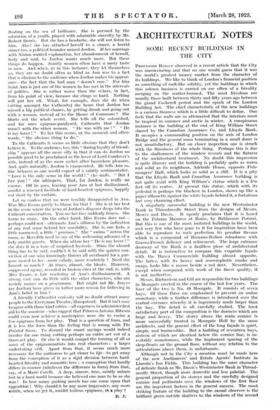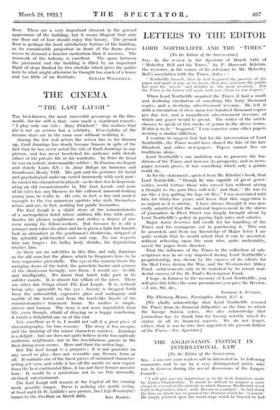ARCHITECTURAL NOTES
SOME RECENT BUILDINGS IN THE CITY PROFESSOR REILLY observed in a recent article that the City was unconvincing and that no one would guess that it was the world's greatest money market from the character of its buildings. We like to think of London's financial position as something of rock-like solidity, yet the buildings in which this solemn business is carried on are often of a frivolity merging on the scatter-brained. The . most frivolous are usually those built between thirty and fifty years ago between the grand Cockerell period and the epoch of the London Building Act. The chief characteristic of the new buildings is a curious thinness which is a little difficult to define. One feels that the walls are so attenuated that the interiors must be tropical in summer and arctic in winter. A conspicuous instance is the building at the end of King William Street shared by the Canadian Assurance Co. and Lloyds Bank. It occupies a Commanding position on the axis of London Bridge and the general mass terminating in a small dome is not unsatisfactory. But on closer inspection one is struck with the flimsiness of the whole thing. Perhaps this is due to the shallowness of the window- reveals and the flatness of the architectural treatment. No doubt this impression is quite illusory and the building is probably quite as warm and solid as its neighbour, Adelaide House, opposite Fish- mongers' Hall, which looks as solid as a cliff. It is a pity that the Lloyds Bank and Canadian Assurance building is not quite axial with King William's statue which is a few feet off its centre. At present this statue, which with its pedestal is perhaps the blackest in London, shows up like a paper silhouette against the white facade behind it, a fortuitous but very charming effect.
A singularly successful building is the new Westminster Bank in Threadneedle Street from the designs of Messrs. Mewes and Davis. It openly proclaims that it is based on the Palaizo Massimo at .Rome, by Baldassare Peruzzi. But this is one of the most imitated buildings in the world, and very few-who have gone to it for inspiration have been able to reproduce to such perfection its peculiar flavour which is a compound of Romano-Italian robustness with Graeeo-French delicacy- and refinement. The large entrance doorway of the Bank is a faultless piece of architectural detail. It is instructive to compare this exquisite facade with the Banea Commerciale building almost opposite. The latter, with its heavy and overemphatic masks and swags, looks like a moose beside a red deer. Nevertheless, except when compared with work of the finest quality, it is not ineffective.
Messrs. Richardson and Gill are responsible for two buildings in Moorgate erected in the course of the last few years. The finer of the two is No. 49 Moorgate. It consists of, seven bays. Of these three are emphasized to prevent an undue monotony, while a further difference is introduced over the central entrance Whereby it is ingeniously made larger than the bay, The detail is all carefully studied. The leaSt satisfactory part of the composition is the dormers which are large and heavy. The storey above the main cornice is more successfully treated in Moorgate Hall by the' same- architects, and the general effect of the long façade is quiet, simple, and businesslike. But a building of seventeen bays,- sixteen of which arc identical below the cornice line, is in- evitably monotonous,. while the haphazard spacing of the shop-fronts on the ground floor; without any relation to the articulations above them, is unfortunate.
Although not in the City a mention must be made here of the new Auctioneers' and Estate Agents' Institute in Lincoln's Inn Fields. This building has the same character of delicate finish as Mr. Davis's Westminster Bank in Thread- needle Street, though more domestic and less palatial. The general proportion of its storeys and the ea" refully designed cornice and pediments over the windows of the first floor are the important factorS .in the general success.. The most, Striking feature of the building to the casual observer is the brilliant green outside shutteri to the windoWs of the seconii
floor. These arc a very important element in the general appearanCe of the building, but it seems illogical' that only one floor out of four should enjoy this luxury. The ground floor is perhaps the least satisfactory feature of the building, as its considerable projection in front of the floors above seems to demand a heavier rustication than it receives. The ironwork of the balcony is excellent. The space between the pavement and the building is filled by an important flight of steps flanked by two obelisks which gives the public note to what might otherwise be thought too much of a house















































 Previous page
Previous page